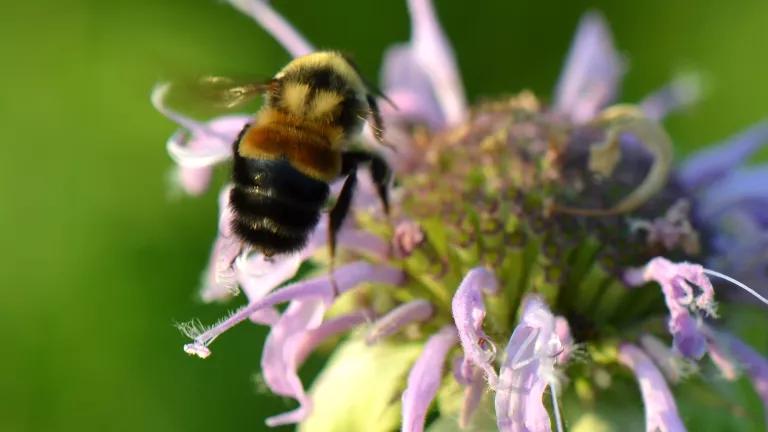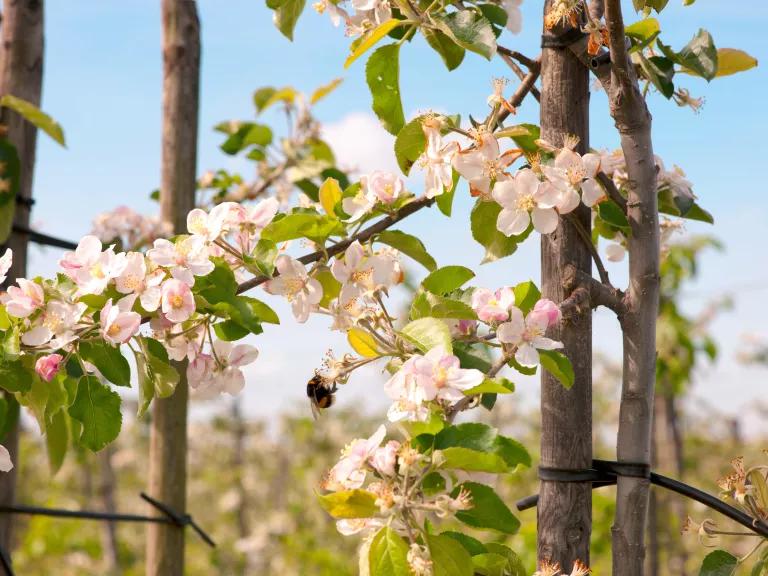UPDATED: Another Court Victory for the Rusty Patched Bumble Bee
A court sided with NRDC in its latest lawsuit to protect the endangered rusty patched bumble bee, paving the way for critical habitat protections.

UPDATE: In February 2024, after months of negotiations, NRDC and the U.S. Fish and Wildlife Service entered into an agreement requiring the agency to make a new critical habitat determination by November 20, 2024. The agreement ensures swift progress toward habitat protections for the rusty patched bumble bee, which may otherwise have been delayed indefinitely.
In response to a lawsuit by NRDC and partners, a federal judge struck down the U.S. Fish and Wildlife Service’s 2020 determination not to protect ‘critical habitat’ for the rusty patched bumble bee. The court decision is a crucial step toward securing federal protections that will not only help recover this critically endangered bee, but support habitat for a wide variety of imperiled pollinators and other wildlife.
The rusty patched bumble bee was once common throughout the northeastern and midwestern U.S., ranging northwards into Canada. But since the 1990s, it has disappeared from nearly 90% of its historical range; it is now found almost exclusively in small, isolated pockets in the upper Midwest. Its decline mirrors broader declines in bees, and insect life generally, in recent decades—stemming from habitat loss, widespread ecological contamination with pesticides like neonicotinoids, parasites, and disease.
These losses are often the unseen face of the biodiversity crisis, but they also mark a threat to the future of our food supply. The rusty patched bumble bee and other wild bees are important pollinators of many crops, and recent research shows that many fruit and vegetable crops are “pollinator-limited” across the country and the world, meaning farmers are producing fewer fruits and vegetables because of a lack of bees and other pollinators.

This decision is the latest in a long history of litigation over protections for the bee. The Xerces Society petitioned the Service to list the bee as endangered under the Endangered Species Act (ESA) in 2013. After the Service failed to respond for years, NRDC and Xerces sued in 2014. As a result, the Service finally listed the bee, but then the Trump administration tried to delay protections in 2017. NRDC sued again, and the Service relented, giving the bee protection under the Act.
But when it listed the bee, the Service declined to identify ‘critical habitat’—federally protected geographic areas determined to be essential for species’ survival and recovery. Federal agencies must ensure that any action they take—like approving a permit, funding a project, or managing federal lands—does not ‘destroy or adversely modify’ critical habitat. In other words, critical habitat is a crucial safeguard for the places that imperiled species call home.
The Service had until 2019 to designate critical habitat for the rusty patched bumble bee. That deadline came and went with no protections, so NRDC sued a third time in 2019. That case resulted in a settlement requiring the Service to make a decision about critical habitat by July of 2020.
However, the Service decided in August of 2020 not to award critical habitat protections, relying on a narrow exemption for circumstances in which designating these areas would be “not prudent.” The Service claimed that, for a number of questionable reasons, protecting the bee’s habitat would have little to no benefit. NRDC, the Center for Biological Diversity, and Friends of Minnesota Scientific and Natural Areas then sued again—NRDC’s fourth lawsuit to protect the bee.

Ultimately, the D.C. District Court agreed that the Service’s explanations were either not supported by information before the agency, or irrelevant to the proper question: whether designating critical habitat would benefit the bee. The court vacated the agency’s decision, sending it back to the drawing board.
The decision is a win for the bee, but also for habitat protections for vulnerable species more generally. In making its decision, the Service relied on a number of dangerous assumptions that would have undermined habitat protections under the ESA for many species. The court’s opinion dispensed with these assumptions, helping to ensure that the ESA remains one of our most important and effective tools for combatting the biodiversity crisis.
It is now crucial that the Service quickly designate critical habitat for the rusty patched bumble bee. Especially important are large areas of high-quality habitat that contain abundant wildflowers, native grassland, and nesting and overwintering habitat. It is also critical to consider areas that are relatively protected from near-ubiquitous contamination with pesticides like neonicotinoids, which the Service identifies as one of the leading threats to the bee.
As we have for nearly a decade, NRDC will continue to monitor the Service’s progress and intervene as necessary to ensure the agency complies with the law. The future of the rusty patched bumble bee—and our nation’s pollinators generally—is simply too important for the Service to shirk its duties under our nation’s most effective wildlife protection law.




